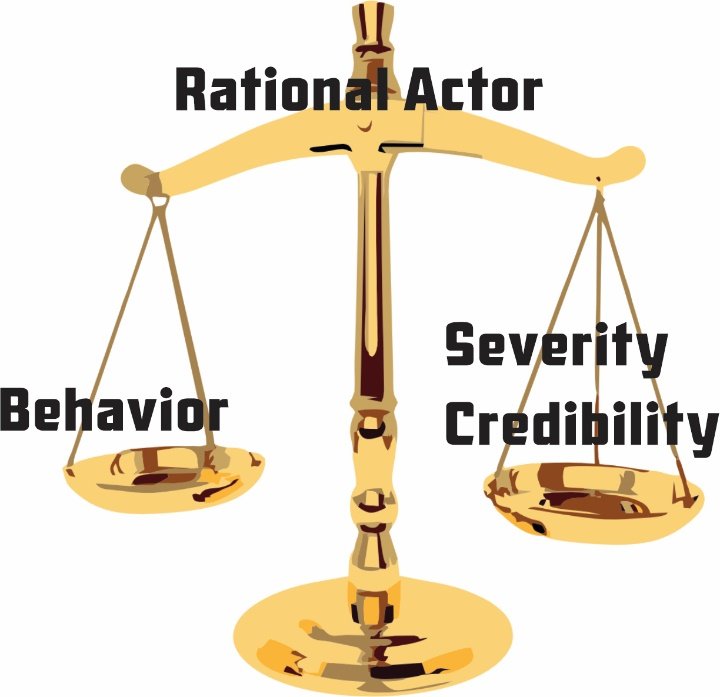
Deterrence and the Interagency Process, Part 1: Deterrence
I came across an interesting article on LinkedIn on deterrence and how the military should be in control of it. I started a comment and midway through; I opened another browser tab to a quick search. When I got back to LinkedIn, my comments and the original post were gone. It surprised me and left me a bit frustrated. Searches on LinkedIn turned up nothing, either on my draft comments or the post I wanted to comment upon.
This post picks up on what I started in two parts. Part 1 looks at deterrence and part 2 looks at the interagency process. Rationality, bounded rationality, rational actor theory, bureaucratic theory, critical thinking, path dependency, and punctuated equilibrium are key analytical concepts. There are references to relevant blog posts at the end of both parts for those that want to dig deeper into these topics. Many of the blog posts provide references to the underlying theory.
First, deterrence. What is it and does it work?
From World 101:
“Deterrence simply means dissuading bad behavior with the threat of significant punishment.
For deterrence to work, two conditions should be present: severity and credibility.”
Perhaps the first recorded evidence of deterrence is the Melian dialog that is part of the Peloponnesian War between Athens and Sparta. While this may be a bit of a stretch since Athens was trying to compel behavior rather than deter it, the principles are the same. Athens wanted to compel Melos’ submission, and the dialog records their failed efforts. Melos refused to submit, and Athens attacked the city. Deterrence and “bad behavior” are somewhat relative. Bad behavior is potentially in the eye of the beholder and deterrence is a form compelling another’s actions or at least modifying their behavior.
From my somewhat limited experience, it seems to brief better than it actually works in the national security realm. We tried it with Russia over Georgia. It did not work and Russia then went on to take the Crimea and then invade Ukraine. It does not seem to work with North Korea and Iran and perhaps not with Saddam era Iraq. Perhaps the significant case in which it worked was/is Mutually Assured Destruction, which kept the Cold War cold.
Why does some deterrence work, and others do not? If we go back to the terms severity and creditability, we may find the answer. To be effective, the parties involved in deterrence must share some elements of rational behavior and shared definitions of pain and creditability. If the adversary has a different view of rationality, what we see as severe and creditable may be very different to the adversary. Therefore, we need to engage in critical thinking and understand cognitive bias.
However, the bureaucracy the develops deterrence policies and actions also suffers from cognitive bias. Our policy development and interagency process need to understand both our own cognitive biases and those of our adversaries, as well as how our adversaries think.
Part 2 looks at the bureaucracy and the interagency process.
Rational Theories
- The Tragedy of the Commons: Rational Actors
- The Tragedy of the Commons: The Political Commons
- The Tragedy of the Commons: Wicked Logic
- Why do we act in other than our self-interest? Is the rational actor/choice theory valid?
- Measurement and Observation Alters the System: What Does this Mean for Social Science Research?
- Thoughts on Ukraine, Part 6: Mutual Destruction?
- Social Justice and the Free-Rider Problem
- Critical Thinking: An Introduction to Key Components and Dimensions
- Critical Thinking: Decisions and System 1 System 2 Thinking
- Critical Thinking: Bounded Rationality and Time
- Critical Thinking: Logic and Rationality
- Critical Thinking and Policy Development and Analysis
- Critical Thinking: Correlation, Causation, and Control
- Virtue: Honor and Integrity
Path Dependency and Punctuated Equilibrium Posts
- Path Breaking Strategy, Part 1: Introduction and Theory
- Pathbreaking Strategy, Part 2: Conceptual Framework
- Pathbreaking Strategy, Part 3: Case Studies
- The Rise of American Bureaucracy
- Reconstructing History, Part 4: Multiple Punctured Equilibriums
- Reconstructing History, Part 6: Culture, History, and the Future
- Reconstructing History, Part 7: Conflict, History, and the Future
- Education Reform, Part 2
- Education Reform, Part 3
- Teachers’ Unions and Critical Theories
Bureaucracy
- Creating the Monster: The American Bureaucracy
- The Rise of American Bureaucracy
- The Bureaucratization of the Military, Part 1: Huntington and the Balance of Forces
- The Bureaucratization of the Military, Part 2: The Nutcracker
- The Bureaucratization of the Military, Part 3: Corporateness and Bureaucracy
- Regulatory Capture and other Bureaucratic Problems
- Defending the Republic, Part 1: Introduction
- Defending the Republic: Scenario 1 Regulatory Capture
- Defending the Republic: Scenario 2 Policy Domination
- Ethics, Morality, and Virtue: Relative vs. Absolute Meaning
- The Looming NCO Crisis, Part 3: Military Culture
- Part 4: The Spanish-American War, the American Empire, and Progressism
- Critical Thinking and Policy: The Wars on Drugs and Poverty
- Part 4: Policy Development
- Government has a Monopoly on Coercive Power
- Corporatism, Part 1: Overview
- Corporatism, Part 2: The Web of Influence and Power
- Part 1: Overview of the Inflection Points
- Part 2: Judicial Review
- Part 6: WWII





